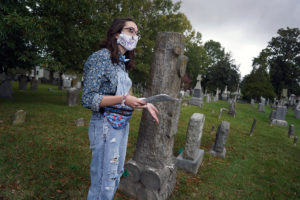The past comes alive in historic Fredericksburg, but each Halloween, it’s the dead who are memorialized by University of Mary Washington’s Historic Preservation Club.

Earlier this month, the club’s annual Ghostwalk – a popular attraction for the past 36 years – transformed into “Graves and Ghouls,” a graveyard tour that was socially distanced due to the ongoing pandemic. Small groups visited Fredericksburg City Cemetery to learn about tombstones and those entombed there. Twenty UMW students contributed to the project, serving as tour guides and script writers and helping with marketing and social media.
“It’s completely different from Ghostwalks of the past,” said Megan Williams, a junior history and historic preservation double major, who serves as the club’s vice president. She and president Cody Youngblood were inspired to create the tour after taking Professor Andréa Livi Smith’s “Graves and Burial Grounds” course last fall.
“Many people think of cemeteries as strange or mysterious places, but they’re full of art and history,” said Youngblood, a senior historic preservation major who finds the imagery on grave markers particularly interesting. “Everything from a weeping willow to a lamb or a broken column all symbolize different aspects of a person’s life or the story the family wanted to tell on their loved one’s headstone.”
Fredericksburg’s spookier side was on full display on the tour, with participants visiting the final resting places of some of the city’s more than 3,300 dead, from notable locals – doctors, lawyers, soldiers, mayors, and civic and religious leaders – to average citizens.
While exploring the cemetery, the oldest in Fredericksburg and a Virginia Historic Landmark, visitors learned about the city’s only mausoleum and unique architectural designs like the “corn-cob” fence surrounding one plot. They also got a crash course in Victorian-era funerary practices, such as the use of zinc or “white bronze” markers and ornate “Woodman of the World” graves shaped like tree stumps.
After leading Ghostwalks for each of her four years at UMW, Alexandra Erpenbach ’20 said she enjoyed being in the audience for the first time. A former historic preservation major, who also took Smith’s course, Erpenbach even discovered a few things she hadn’t known.
“I learned that it’s bad luck to be the first buried in a cemetery,” she said, referring to iron-worker William James Drinan, who worked for Hunt Iron Works, the company that made the massive gate for the adjoining Confederate Cemetery. Upon his death in 1844, he became the first to be interred in the City Cemetery. “That person’s soul supposedly becomes the guide for other souls that are laid to rest there.”
What could be more eerie than that?
Happy Halloween!





